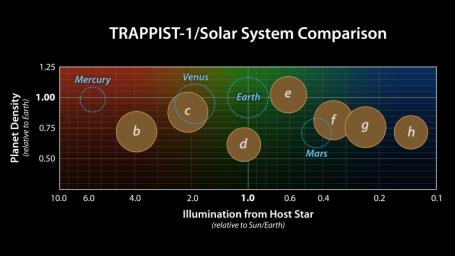
|
Comparing TRAPPIST-1 to the Solar System
- Click the image above for a larger view
- Full-Res JPEG (4800 x 2700) (591.6 kB)
- Full-Res TIFF (4800 x 2700) (4.4 MB)
Caption:
This graph presents known properties of the seven TRAPPIST-1 exoplanets (labeled b through h), showing how they stack up to the inner rocky worlds in our own solar system.
The horizontal axis shows the level of illumination that each planet receives from its host star. TRAPPIST-1 is a mere 9 percent the mass of our Sun, and its temperature is much cooler. But because the TRAPPIST-1 planets orbit so closely to their star, they receive comparable levels of light and heat to Earth and its neighboring planets.
The vertical axis shows the densities of the planets. Density, calculated based on a planet's mass and volume, is the first important step in understanding a planet's composition. The plot shows that the TRAPPIST-1 planet densities range from being similar to Earth and Venus at the upper end, down to values comparable to Mars at the lower end.
The relative sizes of the planets are indicated by the circles.
The masses and densities of the TRAPPIST-1 planets were determined by careful measurements of slight variations in the timings of their orbits using extensive observations made by NASA's Spitzer and Kepler space telescopes, in combination with data from Hubble and a number of ground-based telescopes. These measurements are the most precise to date for any system of exoplanets.
By comparing these measurements with theoretical models of how planets form and evolve, researchers have determined that they are all rocky in overall composition. Estimates suggest the lower-density planets could have large quantities of water -- as much as 5 percent by mass for TRAPPIST-1d. Earth, in comparison, has only about 0.02 percent of its mass in the form of water.
For additional information on the Kepler and the K2 mission, visit www.nasa.gov/Kepler .
Background Info:
NASA's Jet Propulsion Laboratory, Pasadena, California, manages the Spitzer Space Telescope mission for NASA's Science Mission Directorate, Washington. Science operations are conducted at the Spitzer Science Center at Caltech, also in Pasadena. Spacecraft operations are based at Lockheed Martin Space Systems Company, Littleton, Colorado. Data are archived at the Infrared Science Archive housed at Caltech/IPAC. Caltech manages JPL for NASA.
For additional information about the Spitzer mission, visit http://www.nasa.gov/spitzer and http://spitzer.caltech.edu .
For additional information about exoplanets, visit https://exoplanets.nasa.gov/ .
Cataloging Keywords:
| Name | Value | Additional Values |
|---|---|---|
| Target | TRAPPIST-1 | |
| System | TRAPPIST-1 | |
| Target Type | Exoplanet | |
| Mission | Spitzer Space Telescope | Hubble Space Telescope (HST), Kepler |
| Instrument Host | Spitzer Space Telescope | TRAPPIST, Hubble Space Telescope, Kepler |
| Host Type | Space Telescope | Ground-Based Telescope |
| Instrument | ||
| Detector | ||
| Extra Keywords | Color, Infrared, Orbit, Water | |
| Acquisition Date | ||
| Release Date | 2018-02-05 | |
| Date in Caption | ||
| Image Credit | NASA/JPL-Caltech | |
| Source | photojournal.jpl.nasa.gov/catalog/PIA22095 | |
| Identifier | PIA22095 | |
